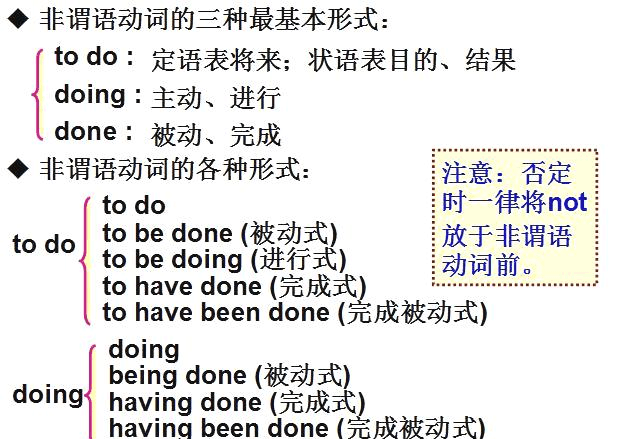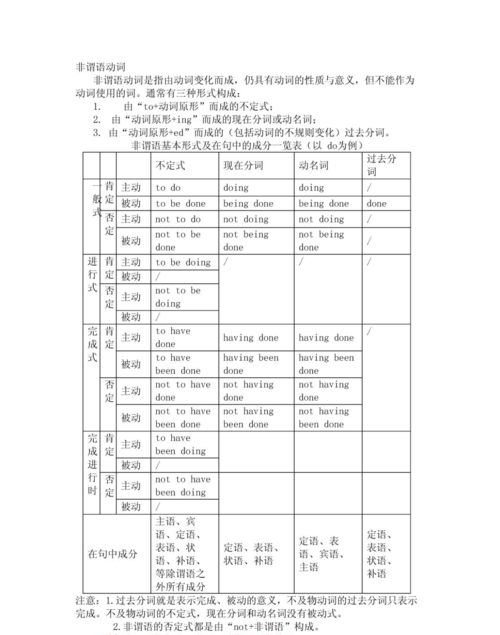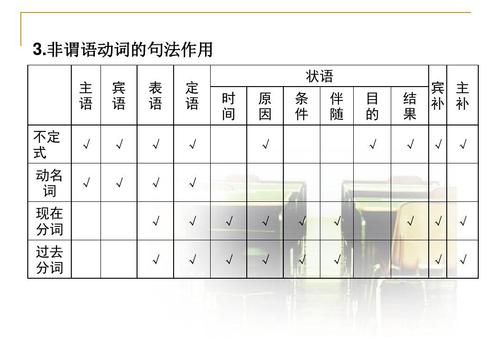本文目录
非谓语变形形式有哪些
一、非谓语动词的概念
动词的基本用法是作谓语。当句中已经有了谓语动词了,要选或要填的动词就只能用非谓语形式了。
非谓语形式有三种:1、动词不定式:to do 2、动词的ing : doing 3、 动词的过去分词:done
二、三种形式的含义(基本用法)
不定式:表示目的和将来;动词的ing:表示主动和进行;过去分词:表示被动和完成。
三、非谓语动词的时态和语态
一般式
完成式
进行式
不定式
主动 to do to have done to be doing
被动 to be done to have been done
ing 形式
主动 doing having done
被动 being done having been done
过去分词 被动 done
四、非谓语动词的否定形式
在非谓语动词前加not, never. 即 not / never to do, not / never doing
五、非谓语动词的复合结构
不定式的复合结构:for / of sb. to do sth.
动词 ing 形式的复合结构:宾格或所有格+doing (-ing 形式作主语时,用的所有格+doing)
六、非谓语动词的做题步骤
1、 判定是否用非谓语形式。方法:看看句子中是否已有了谓语动词了.
2、 找非谓语动词的逻辑主语。方法:非谓语动词的逻辑主语一般是句子的主语。
3、 判断主被动关系。方法:非谓语动词与其逻辑主语的主动还是被动关系。
4、 判断时间关系。方法:分析句子,看看非谓语动词所表示的动作发生在谓语动作之前、之后还是同时。之前常用 done; 之后常用to do; 同时常用doing.
学习非谓语形式时,建议把三种形式一起来比较学习,会更加有效一些。
一、非谓语动词作主语和表语的比较
1、不定式和动名词作主语和表语
a. 不定式表示一次性的、具体的动词。 动词ing 常表示一般的、泛指的或习惯性的动作。如:
________ is a good form of exercise for both young and old.
A. The walk B. Walking C. To walk D. Walk
(分析) a good form 暗示泛指一般的行为,用动名词作主语,选 B
b. 不定式作主语时,常用it 作形式主语,即用句型:It is + adj. / n. + (for / of sb. ) to do sth.
It’s important for us to learn English well.
It’s kind of you to help us.
注意:下面几个句型是用动名词:
It’s no good / use doing sth.
It’s useless doing sth.
There is no need to do sth.
2、不定式、动名词、分词作表语的比较
1、 不定式、动名词作表语,.表示主语的内容。如:
My job is teaching / to teach English. (teaching / to teach English 是my job的内容)
Knowing who we are means knowing what we like to do. (主表语要用同一种形式)
2、 分词作表语
记住:一些表示情感、情绪的动词,常用分词形式作表语。现在分词表示主语的性质特征,用过去分词表示主语的状态。常用动词:surprise (使某人吃惊), surprising (令人吃惊), surprised (主语)感到吃惊)类似动词有:excite (激动),astonish (惊奇),shock (震惊),scare (惊恐), disappoint (失望),move (感动),
如:The movie is exciting. We are excited at the news.
3、 在seem / appear (似乎,好像), prove / turn out (被证明是), remain (仍然是,尚待)等连系动词后,可用不定式作表语。如: He seemed (to be ) very happy.
Having a trip abroad is good for the old couple, but it remains ______ whether they will enjoy it. (to be seen)

非谓语动词固定搭配顺口溜
一、动名词
1.动词后加动名词doing作宾语 (V. + doing sth.)
admit 承认 appreciate 感激,赞赏 avoid 避免 complete 完成 consider 认为 delay 耽误 deny 否认 detest 讨厌 endure 忍受 enjoy 喜欢 escape 逃脱 prevent阻止 fancy 想象 finish 完成 imagine 想象 mind 介意 miss 想念 postpone 推迟 practise 训练 recall 回忆 resent 讨厌 resist 抵抗 resume 继续 risk 冒险
suggest 建议 face 面对 include 包括 stand 忍受 understand 理解 forgive 宽恕 keep 继续
2.词组后接doing
admit to prefer…to be used to lead to devote oneself to object to stick to busy look forward to(to为介词)
pay attention to resort to prior to
have trouble/difficulty (in) doing
spend time (in) doing
no good, no use, It's worth…, as well as, can't help, It's no use /good be tired of
be fond of be capable of be afraid of be proud of think of / about hold off
put off keep on insist on count on / upon set about be successful in good at take up give up burst out prevent … from… feel like
二、不定式
1.动词后加不定式做宾语
afford aim appear agree arrange ask be decide bother care choose come dare demand desire determine expect elect endeavor hope fail happen help hesitate learn long mean manage offer ought plan prepare pretend promise refuse seem tend wait wish undertake
2.动词后加不定式做宾补
advise allow appoint believe cause challenge command compel consider declare drive enable encourage find forbid force guess hire imagine impel induce inform instruct invite judge know like order permit persuade remind report request require select send state suppose tell think train trust understand urge warn
3.动词后加there be不定式做宾语
believe, expect, intend, like, love, mean, prefer, want, wish, understand
4.动词后加to be做宾补
Acknowledge, believe, consider, think, declare, discover, fancy, feel, find, guess, judge, imagine, know, prove, see, show, suppose, take, understand

非谓语动词知识点总结及例句
非谓语动词:即不是谓语的动词形式,主要有三大分类:动词的ing形式。
动词的不定式to,do,动词的分词形式(现在分词和过去分词)
非谓语动词可以充当多种成分,如:主语、宾语、表语、定语、状语和宾语补足语。
非谓语动词是历年高考英语的重要考点之一,同时也是较难掌握的难点之一。它贯穿于英语学习和考试过程的始终。但是,只要认真分析、透彻理解、看透本质、准确把握,就一定能在高考中运筹帷幄,游刃有余。

扩展资料:
不定式
1、“to” 是不定式符号还是介词,下列短语中的to 都是介词。
agree to object to close to,come to,lead to,refer to
equal to,familiar to,point to,thank to,devote to,next to,belong to,be used to,look forward to。
2、带to 还是不带to
I have no choice but to give in
I cannot do anything but give in
I saw him enter the classroom
( 但是:He was seen to enter the classroom )
非谓语动词后面跟宾语从句
可以,宾语从句的语法功能和名词是一样的,可以把它看成是名词性成分。并不只有谓语动词才能加宾语,只要是动宾结构都是动词加名词或者从句的情况。
非谓语动词是指在句子中不是谓语的动词,主要包括不定式、动名词和分词(现在分词和过去分词),即动词的非谓语形式。非谓语动词除了不能独立作谓语外,可以承担句子的其他成分。

以上就是关于非谓语动词要加什么,非谓语变形形式有哪些的全部内容,以及非谓语动词要加什么 的相关内容,希望能够帮到您。
